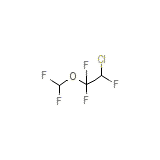Alyrane




Alyrane Brand names, Alyrane Analogs
Alyrane Brand Names Mixture
- No information avaliable
Alyrane Chemical_Formula
C3H2ClF5O
Alyrane RX_link
No information avaliable
Alyrane fda sheet
Alyrane msds (material safety sheet)
Alyrane Synthesis Reference
No information avaliable
Alyrane Molecular Weight
184.492 g/mol
Alyrane Melting Point
56 oC (boiling point)
Alyrane H2O Solubility
Practically insoluble (5620 mg/L)
Alyrane State
Liquid
Alyrane LogP
2.597
Alyrane Dosage Forms
Liquid
Alyrane Indication
Used for the induction and maintenance of general anaesthesia during surgery and cesarean section and also used for analgesia during vaginal delivery.
Alyrane Pharmacology
Enflurane is an extremely stable halogenated ether inhalation anesthetic that allows rapid adjustments of anesthesia depth with little change in pulse or respiratory rate. Enflurane induces muscle relaxation and reduces pains sensitivity by altering tissue excitability. Induction of and recovery from anesthesia with enflurane are rapid. Enflurane may provide a mild stimulus to salivation or tracheobronchial secretions. Pharyngeal and laryngeal reflexes are readily obtunded. In the cardiovascular system, enflurane is a mild negative inotrope, causing a marked decrease in systemic vascular resistance, thus leading to a decrease in mean arterial pressure. This results in a reflex tachycardia. Enflurane also decreases coronary vascular resistance and sensitizes the myocardium to circulating catecholamines. Enflurane is a strong respiratory depressant. It decreases tidal volume but may increase respiratory rate. It also causes bronchodilatationa and inhibits pulmonary macrophage activity and mucociliary activity. Enflurane principle action in the CNS is general anaesthesia with little analgesic effect. It causes increased cerebral blood flow in concentrations and may induce tonic/clonic muscle activity and epileptiform EEG traces. It also causes a marked decrease in skeletal muscle tone. Actions in the genitourinary system include a decreased renal blood flow and glomerular filtration rate and the tone of pregnant uterus is decreased.
Alyrane Absorption
Rapidly absorbed into the circulation via the lungs.
Alyrane side effects and Toxicity
LD50=5.4 ml/kg (oral, rat). Symptoms of acute overdose include nausea, vomiting, irritation to the eyes, skin and nose/throat, headache, dizziness, and drowsiness. Symptoms of chronic overdose include hypotension, cardiac arrhythmias, respiratory depression, and liver/kidney dysfunction.
Alyrane Patient Information
No information avaliable
Alyrane Organisms Affected
Humans and other mammals














